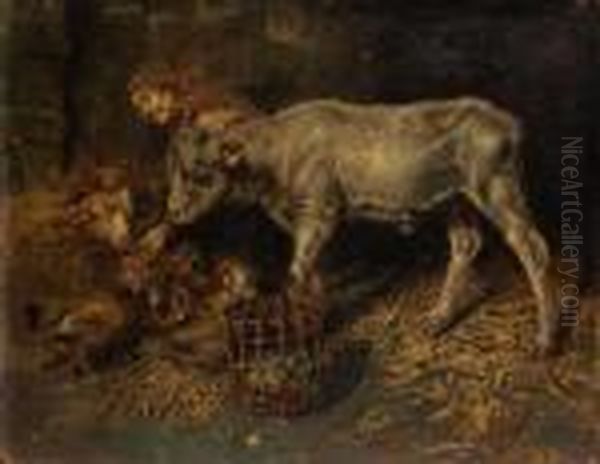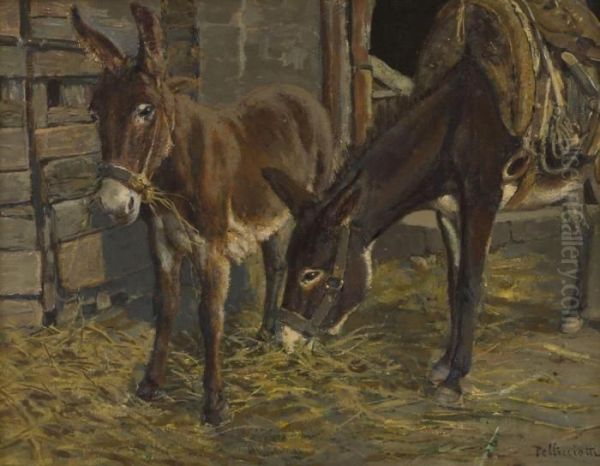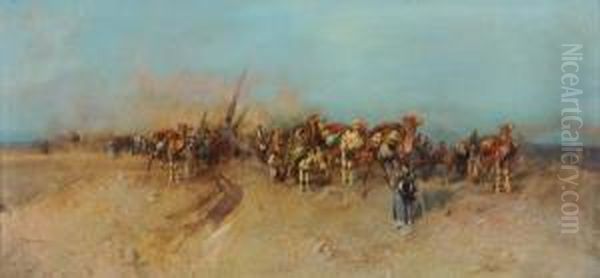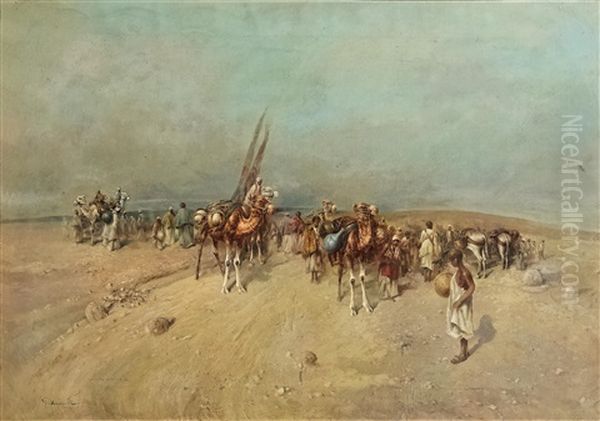Tito Pellicciotti stands as a noteworthy figure in Italian art history, bridging the late nineteenth and early twentieth centuries. Born in 1871 and passing away in 1950, his artistic journey unfolded during a period of significant cultural and social change in Italy. Pellicciotti distinguished himself primarily as a painter, particularly skilled in oil, but also made contributions as a ceramic artist. His work often captured the essence of everyday Italian life, with a particular focus on genre scenes, figures, animals, and landscapes, leaving behind a legacy appreciated by collectors and art enthusiasts.
Early Life and Artistic Formation
Tito Pellicciotti entered the world in 1871 in Barisciano, a commune in the Abruzzo region of Italy. (Some sources suggest a birth year of 1872, but 1871 appears more frequently cited). While details of his earliest training remain somewhat scarce based on available records, it is known that Rome became a significant center for his artistic development and professional life.
He pursued studies in the Italian capital, eventually achieving recognition as a skilled artist or 'master'. Rome provided not only an environment for learning but also opportunities for practical application of his talents. Pellicciotti engaged in architectural decoration, contributing his artistic skills to significant public buildings. Notable examples include decorative work for the Post Office headquarters of the prominent Roman newspaper Il Messaggero and contributions to the city's Municipal Theatre. This experience likely broadened his artistic scope and understanding of large-scale composition and design.
His connection to Rome extended throughout his career, as evidenced by the appearance of his works in Roman auction houses and galleries, such as the Galleria Tritone. This suggests that the city remained a key location for the exhibition and sale of his art, connecting him to the capital's vibrant art market.
Artistic Style and Thematic Focus
Pellicciotti's artistic style is characterized by a foundation in realism, often infused with romantic sensibilities. He possessed a keen eye for detail and a talent for conveying emotion within his compositions. His works demonstrate a deep observation of the world around him, capturing moments of daily life with sensitivity and skill.

His primary medium was oil paint, which he handled with proficiency, creating works noted for their vivid colors and lively compositions. Whether painting on canvas, board, or cardboard, Pellicciotti adapted his technique to suit the subject and support. His brushwork, while detailed, often retained a certain energy that brought his scenes to life.
Thematically, Pellicciotti explored subjects close to the heart of Italian rural and common life. Genre scenes depicting everyday activities and figures were recurrent motifs. He showed a particular affinity for portraying animals, especially donkeys and scenes within stables, rendered with both accuracy and affection. Figures such as gypsy women (zingare) and beggars (mendicanti) also appear, treated with a degree of dignity and realism that avoids caricature. Children and the natural landscape further populated his canvases, reflecting a broad interest in the human condition and its setting.
His approach combined careful observation with an ability to imbue his subjects with character and narrative potential. Even simple scenes often carry an underlying emotional weight or tell a subtle story, inviting viewers to connect with the depicted moments. This blend of realism, romantic feeling, and observational depth defines his unique artistic signature.
Notable Works in Painting
Pellicciotti's oeuvre includes a range of paintings that have appeared in collections and auctions, showcasing his thematic interests and stylistic capabilities. Among his representative works is Animali nella stalla (Animals in the Stable). One version, measuring 45 x 71 cm, highlights his skill in depicting animals within their environment and was estimated at auction between €400 and €600, indicating its market recognition.
Another frequently cited work is La zingara (The Gypsy Woman). A specific example measuring 28.2 x 21.8 cm, likely an oil painting, carried an auction estimate of €300-€500. This subject reflects a common interest among artists of the period in depicting figures perceived as outside mainstream society, often with a romantic or ethnographic lens. Similarly, La mendicante (The Beggar Woman) points to his engagement with social realism and the portrayal of diverse human experiences.

His fondness for donkeys is evident in works like ASINELLI (Donkeys). One such painting, sized 36 x 56 cm, had a higher estimate of €700-€1200, suggesting it might be considered a particularly strong example of his work in this popular theme. The depiction of caravans also features in his portfolio, with titles like CAROVANA and CARAVAN. Examples include an oil on cardboard measuring 21 x 33 cm (estimated €500-€700) and another, possibly oil on board, sized 25 x 25 cm (estimated €700-€1000). These works likely captured scenes of travel or rural life, showcasing his compositional skills on different scales and supports.
Auction records also mention works identified by lot numbers, such as Lotto 306, Lotto 301, Lotto 303, and Lotto 307. These paintings reportedly depicted various life scenes and figures, with dimensions ranging from around 40 x 50 cm to 74 x 48 cm. The presence of these works in auction catalogs, like DIPITTI ANTICHI E DIPINTI DEL XX SECOLO, confirms his established position within the Italian art market of his time and beyond. These specific examples collectively illustrate Pellicciotti's consistent engagement with themes of rural life, animals, and figurative studies.
Contributions to Ceramic Arts
Beyond his recognized work as a painter, Tito Pellicciotti also ventured into the field of ceramic arts. The available information suggests he was a notable ceramicist, producing a variety of objects. These included functional or decorative forms such as cups, plates, and jars. The mention of "gloves" in some descriptions is unusual and might refer to specific, perhaps figural, ceramic objects, glove molds, or potentially be a mistranslation; however, it points towards a diverse ceramic output.
A distinctive feature noted in descriptions of his ceramic work is the use of oil paint for decoration, sometimes applied over a base material described as wood. This suggests potentially unconventional techniques, perhaps combining painted wooden elements with ceramic forms, or using oil paints directly on the ceramic surface in a manner distinct from traditional glazing. Further research would be needed to clarify these specific methods.
His ceramic pieces were often marked with corresponding labels and stamps, indicating a professional approach to identifying and authenticating his work in this medium. This practice underscores that his ceramic activities were a serious aspect of his artistic production, not merely a casual sideline. While perhaps less widely known than his paintings, Pellicciotti's engagement with ceramics adds another dimension to his artistic identity, showcasing his versatility across different materials and techniques.
Context and Contemporaries

Tito Pellicciotti's career spanned a dynamic era in Italian art. He worked after the unification of Italy (Risorgimento), a time when artists navigated national identity alongside regional traditions and burgeoning international movements. His style, rooted in realism with romantic overtones, aligns with trends prevalent in late 19th-century European art, before the full impact of avant-garde movements like Futurism transformed the Italian scene.
While specific records detailing Pellicciotti's direct interactions with many of his contemporaries are scarce based on the provided sources, his activity places him amidst a rich artistic landscape. Italy at the time hosted numerous talented painters. Figures like Giovanni Boldini, known for his flamboyant society portraits, and Giuseppe De Nittis, who captured modern Parisian life, represented Italian artists achieving international fame.
Regional schools remained influential. The Macchiaioli movement, with artists like Telemaco Signorini, had earlier championed a style of painting outdoors using 'spots' (macchie) of colour, influencing subsequent generations interested in light and realism. Pellicciotti's focus on rural life and genre scenes resonates with aspects of this tradition.
Other significant Italian artists active during parts of Pellicciotti's lifetime include Giovanni Segantini, a master of Divisionism whose Alpine landscapes achieved great renown. As the 20th century dawned, Futurism emerged with figures like Giacomo Balla and Umberto Boccioni, radically breaking from tradition, though Pellicciotti's own style seems to have remained more conservative.
Artists like Amedeo Modigliani, though primarily active in Paris, was an Italian contemporary whose unique figurative style developed during this period. The early metaphysical paintings of Giorgio de Chirico also mark the era's artistic innovations.
The sources mention Pellicciotti's name appearing alongside Raffaele Armenise (a painter known for historical and genre scenes) and Luigi Polettopine in certain exhibition contexts or catalogs. While this doesn't confirm direct collaboration or close friendship, it suggests they moved within similar exhibition circles or were represented by the same galleries or auction houses at times.
Other artists mentioned in related contexts, though not necessarily as direct contacts of Pellicciotti, include Michelangelo Pistoletto (a key figure of Arte Povera, representing a much later generation), Remo Squillantini, and Giulio Squillacciotti. Mentioning these names helps map the broader artistic milieu, even if Pellicciotti's direct engagement with many of them remains undocumented. His work exists within this complex tapestry of enduring traditions, regional identities, and emerging modernisms that characterized Italian art from the 1870s to the mid-20th century.
Legacy and Recognition

Tito Pellicciotti's legacy is primarily preserved through his surviving artworks and their continued presence in the art market. His paintings and, to a lesser extent, his ceramics appear in auctions, particularly in Italy, demonstrating ongoing interest from collectors. The estimates and sale prices achieved by works like Animali nella stalla, La zingara, and ASINELLI reflect a consistent level of appreciation for his skill and chosen subjects.
His inclusion in specialized auction catalogs, such as the mentioned DIPITTI ANTICHI E DIPINTI DEL XX SECOLO, solidifies his status as a recognized artist within the canon of 20th-century Italian painting. Galleries like Galleria Tritone in Rome have handled his work, further attesting to his professional standing during and after his lifetime.
While the available sources do not point to membership in major artistic movements or groups, nor do they offer personal anecdotes or extensive exhibition history, his body of work speaks for itself. Pellicciotti contributed to the rich tradition of Italian genre painting, capturing aspects of everyday life, particularly rural scenes and animal studies, with sensitivity and technical competence.
His dual activity as both a painter and a ceramicist marks him as a versatile artist exploring different mediums. He represents a generation of Italian artists who maintained a connection to representational traditions while navigating the cultural shifts of the late 19th and early 20th centuries. His art provides valuable visual documentation of Italian life during his era, rendered with a distinct style that continues to find appreciation among those interested in the period's art.
Conclusion
Tito Pellicciotti (1871-1950) remains a significant Italian artist whose contributions spanned both painting and ceramics. Rooted in realism yet often touched by a romantic sensibility, his work primarily focused on capturing the nuances of everyday life, the character of ordinary people, the charm of animals, and the beauty of the Italian landscape. Active professionally in Rome, where he studied and worked on decorative projects, his paintings like Animali nella stalla, La zingara, and ASINELLI exemplify his thematic interests and technical skill. Though perhaps not aligned with the major avant-garde movements of his time, Pellicciotti carved out a distinct niche, creating works valued for their observational detail, emotional resonance, and connection to Italian cultural identity. His continued presence in art collections and the auction market affirms his enduring, if quiet, place in the history of Italian art.